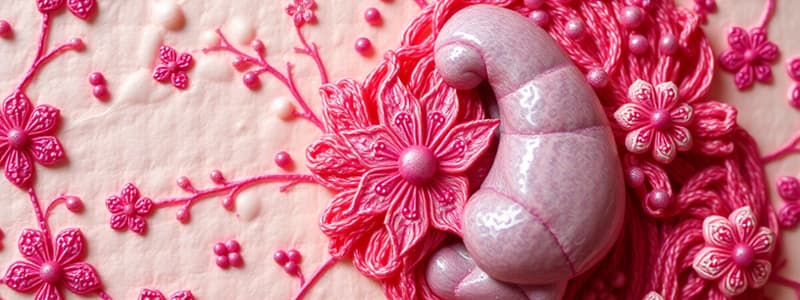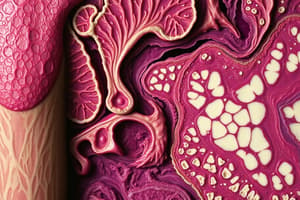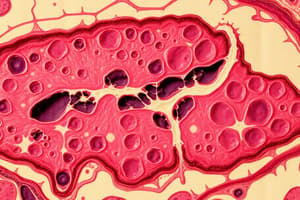Podcast
Questions and Answers
What is the primary role of skeletal muscle tissue?
What is the primary role of skeletal muscle tissue?
- Transporting nutrients
- Facilitating involuntary movements
- Generating electrical signals
- Maintaining posture (correct)
Cardiac muscle cells have multiple nuclei and are under voluntary control.
Cardiac muscle cells have multiple nuclei and are under voluntary control.
False (B)
What type of muscle tissue is responsible for peristalsis?
What type of muscle tissue is responsible for peristalsis?
smooth muscle tissue
Nervous tissue is composed of _____ and _____ cells.
Nervous tissue is composed of _____ and _____ cells.
Match the types of muscle tissue to their characteristics:
Match the types of muscle tissue to their characteristics:
What is the primary function of epithelial tissue?
What is the primary function of epithelial tissue?
Nervous tissue is primarily responsible for generating force in the body.
Nervous tissue is primarily responsible for generating force in the body.
What is the scientific study of tissues called?
What is the scientific study of tissues called?
Connective tissue protects and __________ the body and stores energy.
Connective tissue protects and __________ the body and stores energy.
Which type of cell junction is responsible for forming leakproof connections?
Which type of cell junction is responsible for forming leakproof connections?
Desmosomes connect adjacent cells and help in resisting contraction.
Desmosomes connect adjacent cells and help in resisting contraction.
Which junction anchors cells to underlying tissues?
Which junction anchors cells to underlying tissues?
Match the following tissues with their primary function:
Match the following tissues with their primary function:
Which type of epithelial tissue is specialized for secretion and absorption of hormones and other substances?
Which type of epithelial tissue is specialized for secretion and absorption of hormones and other substances?
Stratified columnar epithelium is specialized for absorption and secretion.
Stratified columnar epithelium is specialized for absorption and secretion.
What is the primary function of the basement membrane?
What is the primary function of the basement membrane?
Epithelial cells are said to be __________ cells due to their distinct surface orientations.
Epithelial cells are said to be __________ cells due to their distinct surface orientations.
Match the following classifications of epithelial tissues with their descriptions:
Match the following classifications of epithelial tissues with their descriptions:
Which type of epithelium lines the majority of the upper respiratory tract?
Which type of epithelium lines the majority of the upper respiratory tract?
Gap junctions allow for communication and direct signaling between adjacent cells.
Gap junctions allow for communication and direct signaling between adjacent cells.
What is the function of goblet cells in non-ciliated simple columnar epithelium?
What is the function of goblet cells in non-ciliated simple columnar epithelium?
Stratified squamous epithelium can be either ____________ or non-keratinized.
Stratified squamous epithelium can be either ____________ or non-keratinized.
Which type of gland secretes hormones directly into the blood?
Which type of gland secretes hormones directly into the blood?
Which of the following glands secretes products via exocytosis from the apical surface only?
Which of the following glands secretes products via exocytosis from the apical surface only?
Holocrine glands secrete their products via exocytosis only from the apical surface.
Holocrine glands secrete their products via exocytosis only from the apical surface.
What type of connective tissue is characterized by sparsely distributed cells and fibers, often including adipose tissue?
What type of connective tissue is characterized by sparsely distributed cells and fibers, often including adipose tissue?
Merocrine glands secrete their products through _________.
Merocrine glands secrete their products through _________.
Match the type of connective tissue with its characteristics:
Match the type of connective tissue with its characteristics:
Which type of protein fiber in the extracellular matrix is the most abundant and provides great tensile strength?
Which type of protein fiber in the extracellular matrix is the most abundant and provides great tensile strength?
Epithelial tissue is typically vascularized, meaning it contains blood vessels.
Epithelial tissue is typically vascularized, meaning it contains blood vessels.
What do you call the fluid and semi-fluid material found in the extracellular matrix of connective tissue?
What do you call the fluid and semi-fluid material found in the extracellular matrix of connective tissue?
The ________ glands are involved in secreting oil, and include structures like acne.
The ________ glands are involved in secreting oil, and include structures like acne.
Which of the following statements about fibroblasts is accurate?
Which of the following statements about fibroblasts is accurate?
What type of connective tissue contains thick collagen bundles that provide great tensile strength?
What type of connective tissue contains thick collagen bundles that provide great tensile strength?
Hyaline cartilage contains a perichondrium.
Hyaline cartilage contains a perichondrium.
What are the cells called that reside in the lacunae of cartilage?
What are the cells called that reside in the lacunae of cartilage?
Connective tissue that provides elasticity is primarily composed of _______fibres.
Connective tissue that provides elasticity is primarily composed of _______fibres.
Match the following types of cartilage with their characteristics:
Match the following types of cartilage with their characteristics:
Which type of connective tissue is primarily responsible for transporting substances throughout the body?
Which type of connective tissue is primarily responsible for transporting substances throughout the body?
The synovial membrane is composed only of epithelial tissue.
The synovial membrane is composed only of epithelial tissue.
What layer covers the organs and cavities lined by a serous membrane?
What layer covers the organs and cavities lined by a serous membrane?
The primary function of mucous membranes is to line _______ that are open to the external environment.
The primary function of mucous membranes is to line _______ that are open to the external environment.
Which connective tissue type is found in tendons and ligaments?
Which connective tissue type is found in tendons and ligaments?
Flashcards are hidden until you start studying
Study Notes
Tissues Overview
- A tissue is a group of cells with a common ancestral cell (progenitor) that performs a coordinated function.
- Four main types of human tissues: epithelial, connective, muscular, and nervous.
- Histology is the scientific study of tissues.
General Functions of Tissues
-
Epithelial Tissue
- Covers/protects the body and lines hollow organs.
- Forms glands.
- Specializes in exchange with internal and external environments.
-
Connective Tissue
- Protects and supports body/internal organs.
- Connects organs, stores energy, and aids immunity.
-
Muscular Tissue
- Specialized cells that contract to generate force and body heat.
-
Nervous Tissue
- Detects/responds to stimuli.
- Generates electrical signals (nerve impulses) for muscle/gland action.
Cell Junctions
- Cell junctions are contact points between adjacent cells; five main types are:
- Tight junctions: create leakproof connections, e.g., stomach lining.
- Adherens junctions: connect adjacent cells and resist pulling; linked to microfilaments.
- Desmosomes: resist contraction and stretching; connect to intermediate filaments.
- Hemidesmosomes: anchor cells to the basement membrane and resist abrasion.
- Gap junctions: protein channels connecting adjacent cell membranes for signal sharing.
Epithelial Tissue
- Functions include protection from injury, secretion of enzymes/hormones, and nutrient absorption.
- Characteristics:
- Defined by number of layers (simple or stratified) and cell shape (squamous, cuboidal, columnar, transitional).
- Epithelial cells are polarized with distinct apical, basal, and lateral surfaces.
Types of Epithelial Tissue
- Simple Squamous: Specialized for filtration and diffusion; includes endothelium and mesothelium.
- Simple Cuboidal: Specialized for secretion and absorption; found in kidney tubules.
- Non-ciliated Simple Columnar: Secretes mucus and absorbs nutrients; includes goblet cells.
- Ciliated Simple Columnar: Moves mucus; found in bronchioles and oviducts.
- Pseudostratified Columnar: Appears stratified but is single-layered; specialized for absorption and secretion.
- Stratified Squamous: Protects against abrasion; can be keratinized or non-keratinized.
- Stratified Cuboidal: Rare; protects ducts and glands.
- Stratified Columnar: Protects against invasion; found in esophageal glands.
- Transitional Epithelium: Provides elasticity and lines organs like the bladder.
Glandular Epithelium
- Glands classified into exocrine and endocrine:
- Exocrine: Secretes products via ducts (e.g., sweat, salivary glands).
- Endocrine: Secretes hormones directly into blood (e.g., thyroid hormones).
- Glands may be unicellular (goblet cells) or multicellular.
- Secretion Types:
- Merocrine: Via exocytosis.
- Apocrine: From apical face, via exocytosis.
- Holocrine: Cells rupture to release secretion.
Connective Tissue
- Contains extracellular matrix (ECM) and cells.
- ECM consists of protein fibers and ground substance (can be liquid, solid, or gel-like).
- Major cell types include fibroblasts, macrophages, plasma cells, mast cells, adipocytes, and leukocytes.
- ECM provides hydration and supports tissue structure.
Types of Connective Tissue
-
Loose Connective Tissue: Includes areolar, adipose, and reticular tissues.
- Areolar: Supports and reinforces organs.
- Adipose: Stores energy, insulates body, and protects organs.
- Reticular: Filters substances in lymph nodes.
-
Dense Connective Tissue: Regular, irregular, or elastic fibers. Provides strength and elasticity.
- Dense Regular: Provides great tensile strength (tendons/ligaments).
- Dense Irregular: Resists pulling forces; found in fasciae.
- Elastic: Provides elasticity; found in lungs and elastic arteries.
-
Cartilage: Comprised of chondrocytes in gel-like ECM; has three types: hyaline (smooth surface at joints), fibrocartilage (strongest), and elastic (provides shape).
-
Bone Tissue: Consists of compact or spongy bone; compact bone features osteons with blood vessels and nerves.
-
Liquid Connective Tissues:
- Blood: Contains plasma and cells; transports nutrients and wastes.
- Lymph: Less protein than blood plasma; consists mainly of lymphocytes.
Anatomical Membranes
- Composed of epithelial and connective tissue layers:
- Mucous membranes: Line cavities open to the external environment, preventing fluid loss.
- Serous membranes: Line internal cavities and lubricate organs.
- Cutaneous membranes: Skin with protective layers (epidermis and dermis).
- Synovial membranes: Line joints with connective tissue, secreting synovial fluid.
Muscular and Nervous Tissues
- Muscular tissue consists of muscle fibers that contract for movement.
- Nervous tissue contains excitable cells that conduct electrical stimuli and produce action potentials.### Skeletal Muscle Tissue
- Long, multinucleate fibers that are striated.
- Responsible for voluntary movements, posture maintenance, and heat generation.
- Connects to bones via tendons.
Cardiac Muscle Tissue
- Composed of branched, striated fibers with a single nucleus per cell.
- Features gap junctions for rapid electrical signal conduction.
- Functions under involuntary control, forming the myocardium or heart wall.
Smooth Muscle Tissue
- Comprises long, non-striated fibers with irregularly-shaped cells containing a single nucleus.
- Cells have a thickened middle and are interconnected by gap junctions.
- Involuntary contractions facilitate processes like peristalsis, airway constriction, and the contractions of the urinary bladder and gallbladder.
Nervous Tissue
- Made up of two primary cell types:
- Neurons: Contain a cell body, dendrites, and an axon; generate electrical signals or nerve impulses.
- Neuroglia: Do not produce electrical impulses; synthesize myelin to enhance the speed of electrical signal transmission.
Summary of Tissue Types
- Tissues consist of cells and extracellular matrix (ECM).
- Epithelial tissues provide coverage and lining for the body, enabling secretion and absorption of substances, as well as protection against mechanical injury.
- Connective tissues link epithelial tissues to deeper layers and offer structural support.
- Muscular tissue facilitates body movement and heat generation.
- Nervous tissue coordinates and regulates responses to stimuli.
Studying That Suits You
Use AI to generate personalized quizzes and flashcards to suit your learning preferences.




